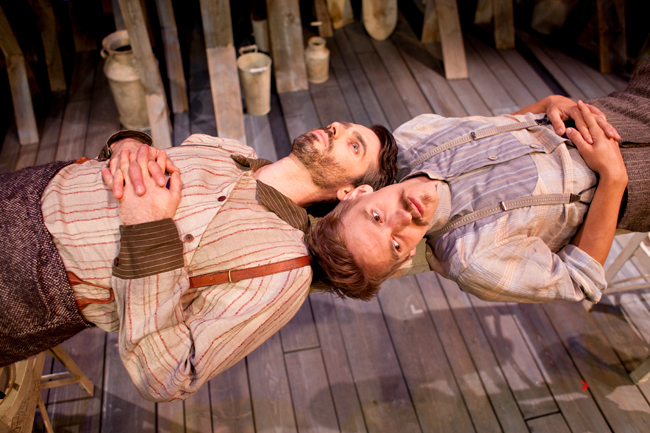The word “cataract” has a double meaning. The first, more common meaning refers to a degenerative eye disease that causes clouding of the eye. The second, lesser known definition of “cataract” refers to a waterfall. These two definitions have nothing in common. Absolutely nothing. However, the play “The Cataract,” written by alumna Lisa D’Amour and directed by fine arts grad student Will Davis manages to unite the two incongruous definitions in such a way that they seem worthy of sharing the same word.
The performance is about two men at the end of the 19th century, Cyrus and Dan, who are working on damming a section of the Mississippi River that flows from a waterfall. Dan has traveled with his significant other, Dinah, from the South to stay in Minnesota with Cyrus and his wife, Lottie, to work on the river dam. Dan and Dinah are lax and easygoing with questionable moral standards, whereas Cyrus and Lottie are uptight, seemingly straight-laced and proper. But as the story and characters unravel, the audience sees that each character has been viewing the world through metaphorical cataracts. The characters have deliberately imposed cloudy lenses over how they view themselves and their surroundings.
“This is a play about a journey towards your true nature. It is about crashing into people who are not like you and what you learn from them,” Davis said.
The characters certainly do crash into each other as their cataracts clear in almost every way possible. There are clashes in personality, in lifestyle choices and in culture. All the tension between the characters lends itself to some very comedic and physical portrayals of the characters’ emotions.
“I love that the physical language, the gestures, of the play hold the same weight as the dialogue. I love that we see two opposing worlds spliced open and thrown together,” Katie Bender, the fine arts grad student who portrays Dinah, said.
The emotional narrative of this play is told through physical expression. The dialogue, to a certain extent, just describes what is going on. Since the set of the play and the props on stage rarely change, much of the dialogue is used to point out that this is a house, that this is a river, that this is Minnesota or that this is a bed. The script is delivered in a Seuss-like style through short, declarative sentences. However, these assertive statements do convey that the characters, Cyrus and Lottie in particular, are unwilling to vocalize their true feelings, and the audience is left to interpret the characters’ true thoughts through their physical expressions.
“Cyrus is a deeply repressed man,” said graduate student Abe Koogler, who plays Cyrus.
Cyrus’ repression leads to some of the more peculiar, surreal elements of “The Cataract.” Magic and surrealism factor prominently into the symbolism of the production. Cyrus carves magic walnuts that glow when opened, and at one point a flower is yanked from Dinah’s eye. The Minnesota where the play takes place straddles the line between the conscious and the subconscious, the real and the imaginary, and the audience is never quite sure which is which.
In all the play is, as Davis puts it, “gloriously strange and hilarious.” While not for the prude or unprogressive theater-goer, “The Cataract” explores, with great emotion, how humans discover who they are.
“It’s about understanding who you are and either falling in love with it or being repulsed by yourself,” Davis said.
Printed on Friday, October 19, 2012 as: Conflict, emotional expression floods new play 'The Cataract'.















